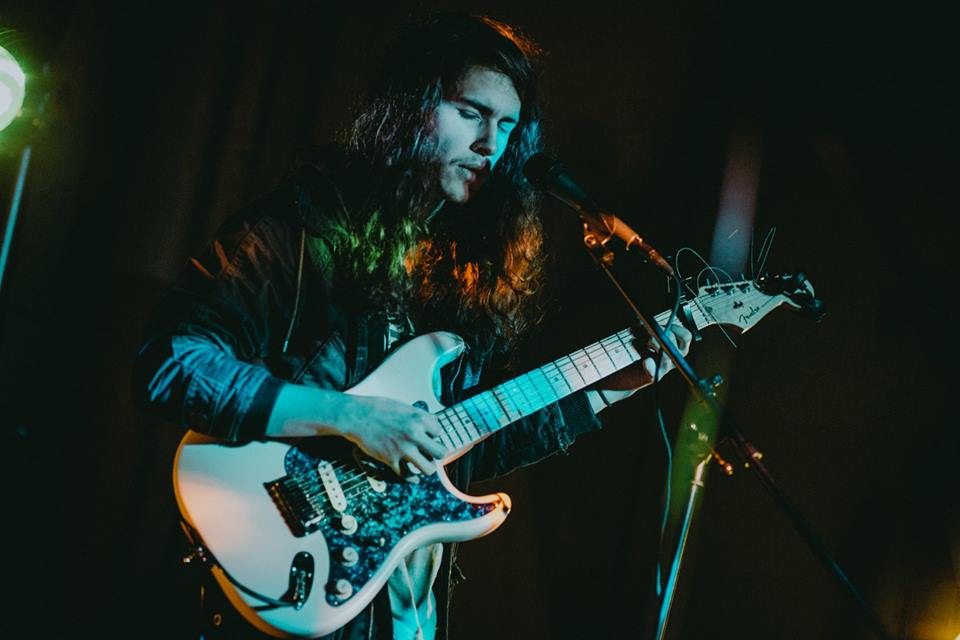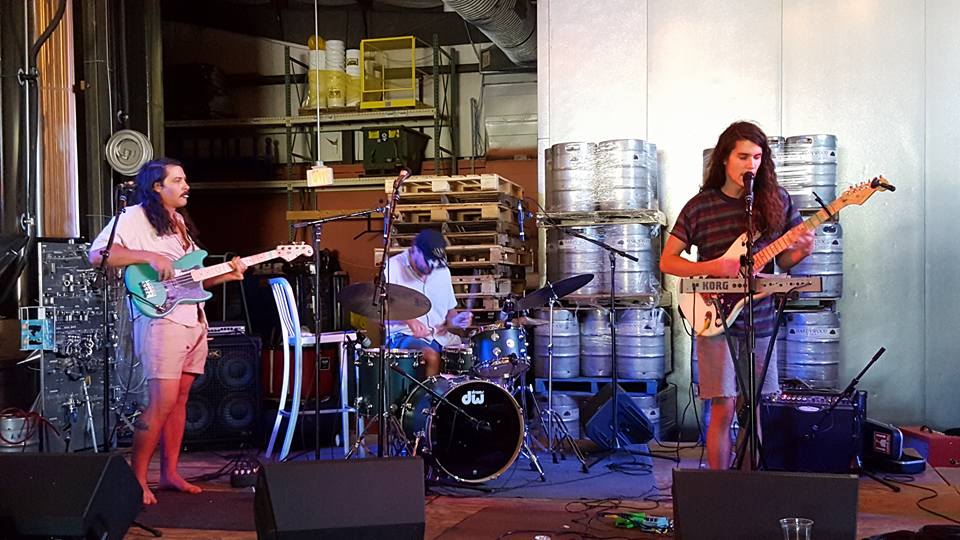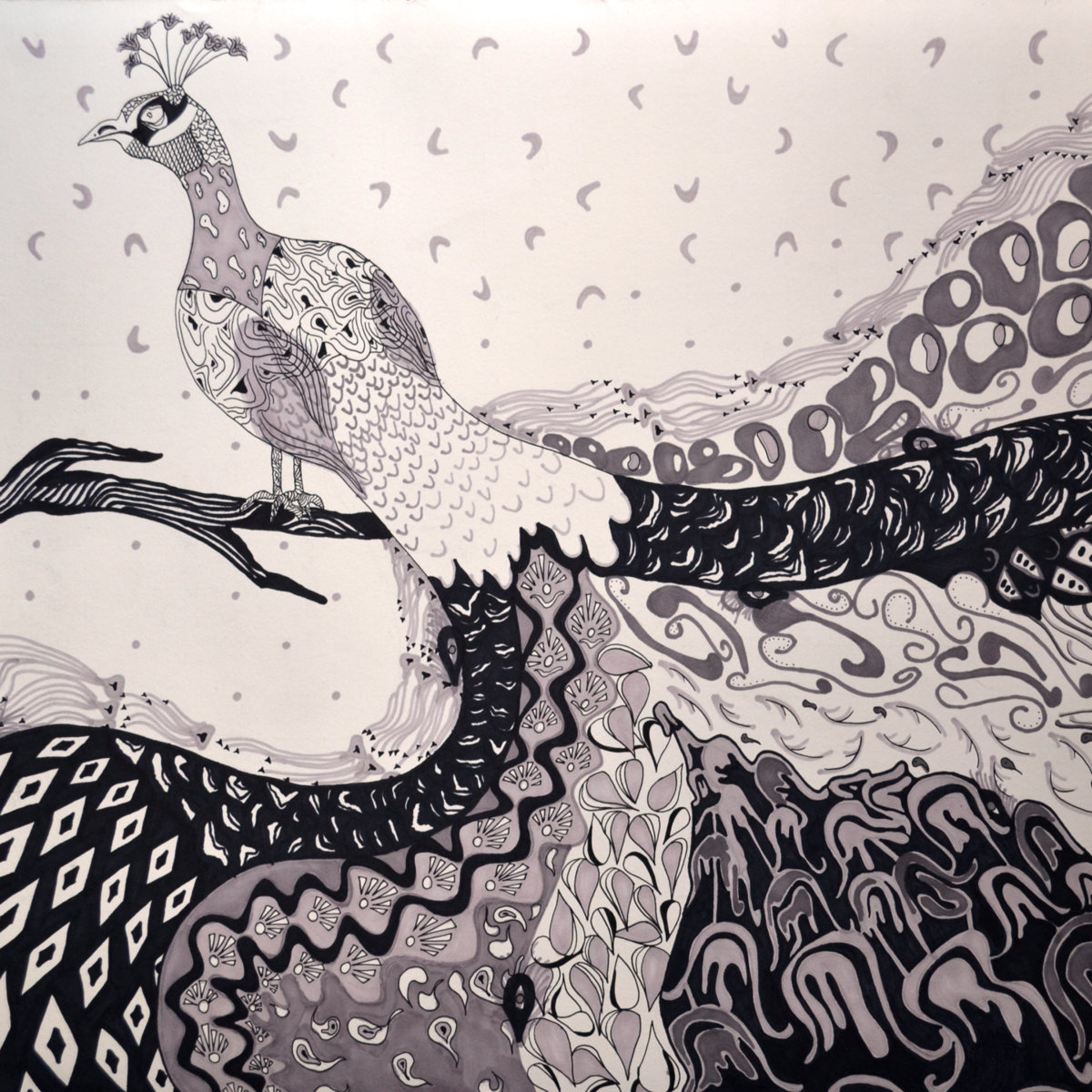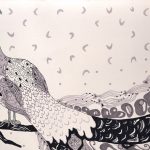The Recording Odyssey Of Recluse Raccoon
Asking musician Timmy Peele, the mastermind behind Recluse Raccoon, to recount the two-plus year recording genesis of his first debut record isn’t easy. He pauses for a good amount of time before each answer, slowly rolling his eyes around as he thoughtfully pieces together memories and observations. His answers are mostly deep and profound, but even with that preparation, he still rambles to a degree, repeating himself at times and glossing over key moments elsewhere, only to bring them up later when talking about something completely different.
It’s no easy feat trying to remember every little thing about a journey you’ve been on for two years. No one’s going to remember how everything precisely unfolded, not to mention the reasons and feelings behind each moment. But Peele’s memory disorientation reaches new level and as you talk to him, you realize it’s because he’s given practically everything he has to this project. His nights, his days, his relationships, his money, and even his living space, every last bit of creative and physical energy has gone into the making of this record. In doing so, he’s made not only a dazzling listening experience, but also shown just how much musicians can achieve with little to rely on except passion and ingenuity.
On Recluse Raccoon’s self-titled debut record, out now on cassette and vinyl, the ambitious and sprawling vision of Peele is fully realized with songs that jump between baroque pop and indie rock with stunning dexterity. It’s a record worthy of the most intimate and detailed examinations, and with that in mind, we set out to get the full scope of what it took for Peele and Recluse Raccoon to bring this masterpiece to the world. It’s unsure how close we got to exposing the pure brilliance of this record, but we definitely learned a lot through a lengthy conversation that weaves through recording, songwriting, and influence with the Richmond music scene serving as the gorgeous backdrop to it all.

When did the album first start coming together?
We started recording it in May of 2016. So a long time ago. Even back when we were recording the Horse EP, a lot of these songs were in the lineup. I kind of wanted to save a few of them. I intentionally wanted to do a quick EP that felt like home. Not much instrumentation on it — couple of guitars, a little bit of keyboard. Not that much extra stuff. I made it intentionally knowing I wanted to do something really big later on with an album. Outsource [parts] and use musicians that I had never tried working with before. Back at that point, it was just me and the drummer Austin [Tekamp].
When did Andrew Murray join on bass?
[Andrew] joined about a month or two after the EP came out. He saw us playing a show, actually at his house. They called it the Ghost House. I think it was a bill with Camp Howard before they were called Camp Howard and were just called Nic Perea I think. Andrew saw us there. I noticed him while we’re playing just bobbing with it in the corner. He came up to me afterwards and suggested a bass part to fill the sound out. I asked him if he wanted to practice so we got together and played, but that same day, he told me he might not be in Richmond longer because he needed to find a place to stay immediately. My roommate had just left and I offered him the space so he just moved in.
Why do you think the album took so long?
Mostly because there was no studio. I did it all on this digital 8-track. Wait, that’s not true. The bass and the drums were recorded with Saw Black on his reel to reel machine. Once we did that, everything else was done on the 8-track.
So you never worked in a studio at all for this?
Never.
How did you record the horns?
I called my buddy Stephen Moser over. I had always been doing this like mouth trumpet stuff, so I had those parts already written while messing around with my 8-track. I called Stephen over and stuck a mic in front of his face and it took him about twenty seconds for him to pick up on what I wanted.
Did you play around with the acoustics of a space at all while recording him?
It’s funny to me that I did so little of that — playing around with the space. I always used two mics for pretty much everything I did. I did the Jimmy Page technique where you put one mic close to whatever you’re doing and one far away. I just did multiple takes of everything. When you hear a violin or trumpet part, it was probably doubled or tripled. Giving that to Adrian Olsen who mixed it was just like… he was shocked.
How many takes would you say most songs have?
So I did it on the 8-track and I would do six or seven tracks of each instruments. Sometimes I would do harmony and sometimes I would just double them.
Let’s look at “Put In The Time” specifically — how many tracks does that one have?
There’s probably like 14 vocal tracks on that song. Most of them weave in and out. The main one of me and the main one of my sister are up front. But I stacked four harmonies and she stacked four harmonies, which were the same harmonies, but we found a balance between each voice.
There’s a lot to unpack in that song then.
I really love music that grows on you. Each time you hear it, you hear something new. That song is one of the ones like that. After I was done, I counted 45 tracks on the song so there’s a lot of stuff happening at once.
Did this make the mixing process tough?
Yeah, it was a bitch. Adrian was like, “What in the world did you do?”
How long did mixing take?
It’s hard to say. We mixed the album in one fell swoop. It was a week process or maybe even five days. He would send me three songs and I would listen to those and then the next day he would send me seven songs including those first three, and then the next day he had taken a stab at all twelve of them. We just kept going back and forth. He works very quick. He’s crazy.
You have all these different instruments. I’m curious if you have a background in any of them.
Not anything classical. I worked with Jessika Blanks who did all the violin. I wrote all the parts for “Put In The Time” that she played, but I didn’t really have a clear part for the last song on the album “Why Do You Shut It Out” so I let her take the reins on it. It was by far the best part that she did on the album. And it kind of showed me that I needed to loosen up a little bit and not try to write everything people were doing.
How did you land on the other instruments you were going to use?
I collaborated a little with my friend Jack Tierney who was in the jazz department. We kind of played around on the piano and talked about what we might want to do. We picked out the harmonies first that we thought the trumpets might do. Even though I don’t have a background in trumpet, the mouth trumpet helped me get an idea of what it was going to sound like. I was pretty confident that that part was going to work.
What other instruments are on the record?
There’s clarinet and flute and saxophone and violin and cello, which is only on “Put In The Time.” The cello part Jessika specifically came up with. She did a lower harmony and we both agreed it wasn’t right for violin. A lot of the instrument stuff was intuitive and felt right at the time.
Did you have the songs all worked out before recording began?
I want to say most everything was pretty close to being finished when we started. Because we did it with Saw [Black] in his basement… well, I guess I should also talk about how we went about starting the recordings. We started with just bass and drums. They come across as sugary and easy to play, but a lot of them are pretty weird and unusual in some type of way. It was really hard to get the drummer and bass player to play the songs without me.
Is that because they don’t run parallel in each song like most rhythm sections?
Yeah. The drummer definitely copies the vocals quite a bit. On top of that, there’s multiple points in the album where the drummer would just count dead space before hitting one note. Other instruments would be playing so the drums needed to give up space for things to happen.
How did you get hooked up with Saw Black?
We knew each other. I loved Azalea Days which he recorded on that same machine. Austin played on I think two of the songs on that album, so they knew each other. Austin had been in that space to record and he liked it. We also knew he had the reel to reel machine which a lot of people didn’t. We would do three songs on the machine and get good takes, and then head back to practice space so I could teach the band three new songs to take over to the next session.
So the songwriting mostly comes from you?
Yeah, pretty much all of it. They help with the arrangements. Austin definitely helped a lot with arrangements. He used to drive up from Norfolk when we were first starting to get these songs together. The two of us working together helped finalize a lot of these songs.
Do you view the Horse EP as blueprints of your songwriting, and this album as the songs being fully constructed?
In a way. I don’t know. It’s hard to talk about, I don’t think I went over eight tracks on any of those EP songs. I wasn’t trying to be as ambitious. I just wanted to get something out so we could start booking shows.
Any desire to go back and revisit those songs?
Not really. I think there’s enough material that Austin and I have together that we don’t really need to go back and take stabs at any of them again. It would be fun though. I really like “Almost Done.” I almost wanted to re-record that and put it on the album.
It seems like a lot of artists put out an EP before their first album, and the bulk of the EP makes it onto the album. Was that just not something you considered?
No. I was pretty happy with the way it turned out. Until that point, they were by far the best recordings I’d had ever done myself. I didn’t really like have any type of idea what the LP was going to sound like until maybe two months before it was finished. The whole time, I never set myself up with a decent mix of them. They were all floating parts that hadn’t been put together yet. I would have these reference scratch tracks, but they were never mixed and sounded so bad.

Since you spent so long working on these without a proper mix, did you lose sight of the finish line so to speak?
I would say so. I felt like I lost sight definitely. I went through a breakup with a girlfriend a year and a half into it. I feel like a good part of the reason for it was because I was spending too much time on the recordings and it definitely hit me. “What am I fucking wasting my time on? I spent years doing this and it’s just a twelve song album. What am I doing?”
When did you really start to see the light at the end of the tunnel?
When I started to do the vocals. Andrew, my roommate and bass player, moved to California and I gutted my closet to make a little studio booth. I also put a microphone inside of the piano and sang into that. This is out of order, but I think that piano is another reason why this album took so long. I went and got my grandfather’s piano from my dad’s house in Norfolk. I bought a van that pretty much died as soon as I got the piano back to Richmond. Taught myself how to tune it and ended up tuning it six times before it was ready to be on there. I think there’s like 270 strings in a piano so it took a long time.
That’s not an easy thing to just pick up and learn either.
Not at all. I built myself a drum key and put a handle on it so I could tune it better. It took me forever to do that. Another reason the process took so long was there was never place to record loud electric guitars. I would have to go to the practice space that we had in Scott’s Addition and spend hours recording, but starting around 2 AM because otherwise there’d be bands there that we shared the space with.
When did you first approach Adrian Olsen about doing the mixing?
It was right when Juice came out by Camp Howard. I heard the first single off that album and I just thought, “there’s no way I’m not going to use this guy. I didn’t care how much it cost. I wanted my shit to sound like that. It was immediate. I remember listening to that song over and over again.
And how did you get hooked up with Citrus City?
I didn’t know [Manny Lemus] that well. I saw him at shows. Occasional chatting. I just sent him the album and he said he loved it and he’d be down to help. Thank God. I feel like Manny has been such a big help to promote this so far.
Since Citrus City is a tape label, how did you get the album pressed on vinyl?
I went back and forth a million times on a vinyl release. I backed out of the idea of doing vinyl when it seemed like I wasn’t going to get a label to help. I ended up paying completely out of pocket for vinyls, which is yet another reason why this all took so long. We funded it completely ourselves and none of us come from money, so we put in a lot of time and work to get it to happen.
I’m really happy with how it works on vinyl too. I feel like each side is its own collection. I just had to get it on vinyl though. It was always the goal. I had spent so much time on this that there was no way I wasn’t going to put it on vinyl. I always felt like I could die happy if I put something out on vinyl that I really care about.
Where did the album cover come from?
My friend Sydney Hubert did the cover. It was a piece that she did six or seven years ago, and I actually had a lot of demos in my iTunes with that picture as the artwork. I had a couple of ideas of what I thought the cover would be. After working with someone to take pictures, it just wasn’t what i wanted. I started racking my brain for what I could use for the cover. I always loved this drawing that she did, so why not use that? At this point, I’m removed enough from the songs that I don’t know what I would have chosen when I was writing them, so why not chose something I liked when I was writing it? And I still love it. It’s great. I like that the name is not on the album too. It makes you twist it to the side to see the label.

And how did you land on a self-titled name for the album?
I almost want to say we didn’t land on a title and that’s how we got it. It was another one of those things of at this point, how can I label or title something that I’m far removed from it. Self-titling just seemed good.
Since these songs are from so long ago, do you still feel excitement over them or are you ready for the next batch of songs?
It’s a mixed bag. I definitely feel like I’ve never heard these songs any bigger than the three piece outside of recording. Working with musicians for the release show was exciting. That’s helped bring these songs back into a fun space. I definitely feel backed up in a way. I’m ready to start teaching the band new stuff.
Have the three of you worked on anything since recording?
I’ve been intentionally not letting myself teach new stuff or work on new stuff. We had two practices where I showed the band two or three new songs and it was pretty apparent we needed to get back to working on the old songs. We didn’t need the distraction.
We’ve been talking so much about recording, but how does your songwriting process work?
I feel like the name Recluse Raccoon came from feeling like the songs weren’t really my own. Feeling like I was being talked to. I felt like I was getting little bursts of inspiration or a message that I needed to hurry up and jot down. I always think of this Tom Waits thing I heard where he said inspiration always comes at the worst point. He would be driving and lyrics would start flowing in and he’d go “God damn it, can you just wait until I can pull over the car and get a pencil so I can start writing this down?” I feel like that’s what it’s like for me. I purposefully named it Recluse Raccoon because I was trying to give this entity credit for something I felt I was outside of. That whole idea and mindset kind of started four years ago and I kind of feel like I’m a different person now.
Is the name of the band something you still line up with then?
It is and I still sympathize with that mindset a lot. I also know that there were some songs that I worked on for hours to figure out what the lyrics were going to be, and others were just handed to me from somewhere.
Which process comes easier to you — working with lyrics first, or the music first?
Music first for sure. I usually will record some type of music and mess around with the vocals. I write exclusively on the 8-track. I’ll put a guitar track down, sing filler lyrics, put harmonies on the filler lyrics, two of the words will feel really good so I know I’ll want to center around that kind of mindset or subject matter, and then I’ll scratch that demo and record a new one that’s closer to the final version. I think I made five or maybe more demos of each song until it came time to record it.
Austin gave me the 8-track in 9th or 10th grade. He bought it and quickly realized he didn’t know how to work it and I was already taking the reins on it. Eventually, I gave him money for it to compensate. That thing has been a huge part of how I write music for sure. I always say I can’t like something until I hear it back. I have to be physically not be playing it, push play, and close my eyes to listen. That’s when I can say it’s right or wrong.
Do you hear any type of lyrical themes come through when you listen to the record?
Not so sure. As much as I feel the songs and transitions flow together in this nice way, I don’t see it being a huge theme album. That’s something I want to start working on in the future. This complete package concept idea. This record is just little bits of life and different moods I was in. “Put In The Time” was about meditation and self-help. The idea that the farther one travels, the less one knows.
“Sleep For A While” is about a friend’s cat that I was watching who was just home alone and real bored. I just personified that as a human and what that would sound like. There’s another one about addiction. It’s all over the place. I do feel that the music ties together in a way, but it is scattered. I kind of like that about music though. Being jarred by the genre switches. I kind of hate when you start an album and you know what the rest of it’s going to be.
Did you try to group the songs together that you felt matched up together with sound or lyrics?
I feel like a lot of the meaning is inferred afterwards. It wasn’t necessarily a big grouping. It was more about what musical changes I felt were best. I spent a lot of time playing the end of one song and the beginning of another. “That one doesn’t work, let’s try this one” until I found the two that locked up. Then I did a lot of planning to get those transition to be really seamless.
Are there any songs that stand out to you?
“Sleep For A While” is probably my favorite. That’s the one about the cat being left alone. The very last song I like a lot too. It’s the one where Jessika did her own part and she blew me out of the water. I was not ready to like something that someone else added on to my music. It was immediately incredible. I hung out with her recently and we were taking about what we are like as people. We’re both so bickery and talk so much shit and so opinionated that it’s weird and hard to work with each other.
We were arguing about the part back then. I thought what I had was good and she didn’t like it. I thought I could go home and try to write something else and she just said, “Give me five minutes.” She went in the other room and put it on sheet music so she could see how the harmonies were going to stack up. She came back in and immediately blew me away. What she did was beautiful. It’s like a movie soundtrack.
What song on the record do you think you worked the most on?
I think I did a pretty good job of not letting myself focus on one song that much. I almost want to say that the ones that have the most stuff on it are the ones I messed with the most. “Put It In The Time” is one of the thickest in that sense. That one or “Sleep For A While.” It has clarinet and flugelhorn and sax as well as the band and even keyboards.
So what was the first listening experience like for you with these songs?
Nerve-wracking for sure. You kind of don’t hear it as a listener until you’re showing it to someone for the first time. It was kind of awful. Eric [Godsey] from The Wimps showed me the stuff from Reel Whirl way back before it came out, and I showed him all of my stuff before being mixed. I didn’t know what it was like to listen to it up until that point. I feel very happy with it though. I feel like when people are done with a record, they have a laundry list of things that they would like to change or do differently. I think I spent enough time on it, and I also never dreamed it would sound that good so I’m really happy with it.
Can you emphasize with that mindset though?
For sure. As time passes, there are more and more things that stick out. Like I can’t believe didn’t ask someone to line up some random hit. It was a weird album to make, but it was a lot of fun to make. Giving up and then deciding not to give up. And embracing the shift from wanting to do everything by myself to trying to be Phil Spector. I don’t know that I’ll ever do something like this again, but I did it and it means a lot to me. I’m super excited for it to finally be out in the world and people can take what they want from it.
Are you excited to finally start to work on new music?
It’s hard to say. I don’t know what that freedom feels like. I basically forgot what that freedom feels like as musician. I think that recording shouldn’t ever take as long as it has taken me. But I see myself pretty quickly getting into the gear of writing again and getting around the 8-track and teaching these ideas to the band. I just never want to be as hunkered down and isolated as I was in the making of this album. I learned later after working with the session musicians that there are a lot of people in Richmond that can play instruments better than I can and maybe I should take advantage of that.
Recluse Raccoon is available now on cassette through Citrus City, on vinyl through the artist, and digitally on Bandcamp. The band next plays in Richmond on Monday, November 5th at The Tomb.



